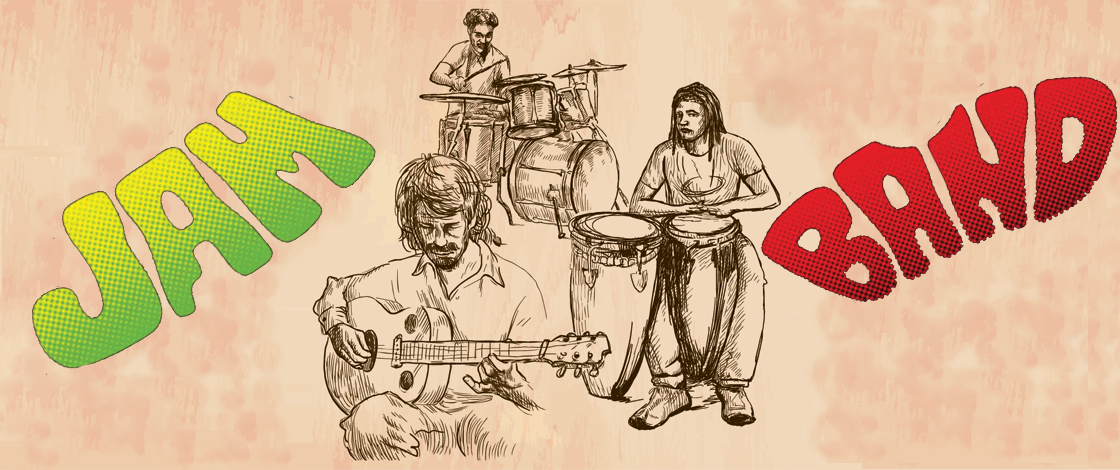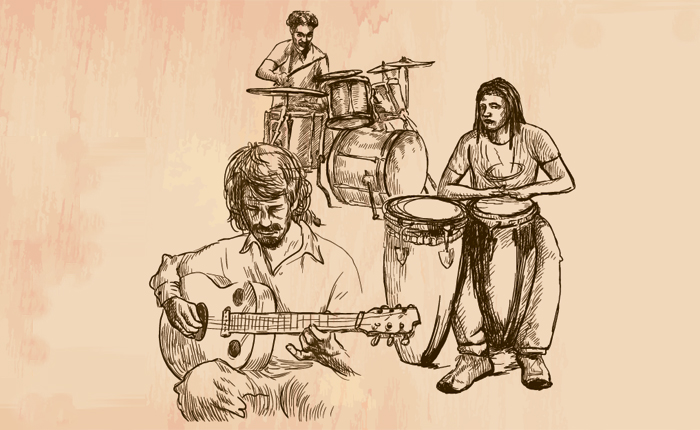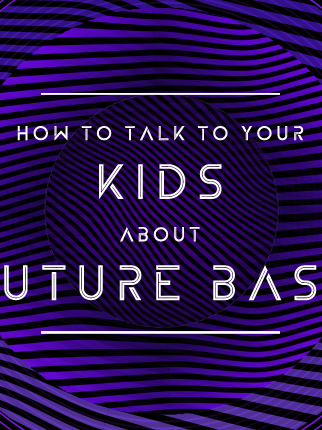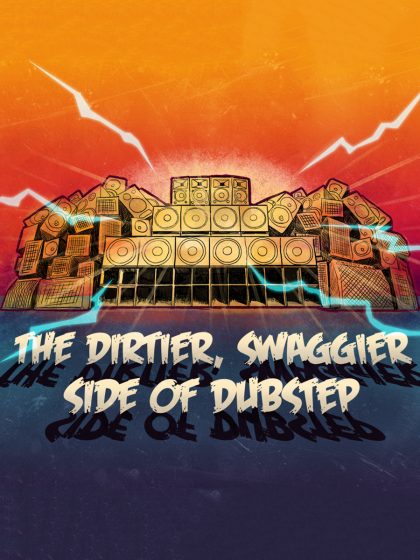How to Talk to Your Kids About Jam Bands

The term “jam band” typically conjures images of barefoot, blissed-out hippies grooving to an extended guitar solo in a grassy field. While this cliché is often true, the jam universe extends far beyond rootsy analog, today encompassing a vast collection of hybrid acts and electronic performers whose improvisational style connects them to five decades of musical history.
The origin of the jam world can in fact be pinpointed to a single day. It was on May 5, 1965, that the Warlocks played their first show at a pizza joint in Menlo Park, CA. Six months later, the group played one of the famous acid tests thrown by counterculture icon Ken Kesey. By that time, they had changed their name to the Grateful Dead.
Inspired by honky-tonk, rock and funk, the Dead became the house band of San Francisco’s Haight-Ashbury district, soundtracking the free love, “turn on, tune in, drop out” cultural revolution taking place in the Bay Area and beyond. Kids from around the country were flocking to San Francisco and having their minds blown wide open by hippie culture. Historian Robert Weir (no relation to the Dead’s guitarist Bob Weir) has posited that, having come to the edge of the continent with no more land to explore, the children of the ‘60s instead explored their inner landscapes, using psychedelics, particularly LSD, to achieve enlightenment. The Grateful Dead were deeply intertwined in the counterculture, with the iconic Beat poet Allen Ginsberg collaborating with the group and guitarist Weir once rooming with Neal Cassady, the inspiration for the character Dean Moriarty in Jack Kerouac’s era-defining On the Road.
“Grateful Dead performances were by design not consciously planned, often reaching their artistic peak when the collective stumbled upon something stunning—when ‘the music played the band,’ as it were.”
The music of the Grateful Dead wasn’t commercially popular and didn’t get radio play; instead, the band grew their name through their expansive, largely improvisational live shows. Three-minute songs were often extended to 20 minutes or more, taking listeners on journeys of sonic and spiritual ecstasy. The music peaked with various guitar and drums solos, foreshadowing the drop phenomenon that would come decades later with electronic music. In other words, the Grateful Dead could jam.
“Grateful Dead performances were by design not consciously planned, often reaching their artistic peak when the collective stumbled upon something stunning—when ‘the music played the band,’ as it were,” author Steven Gimbel wrote in The Grateful Dead and Philosophy: Getting High Minded About Love and Haight. “Instead of using set lists, the Grateful Dead chose songs by experimenting together until a pulse, rhythm, phrase, or riff emerged from the group, suggesting a song.”

No two sets were the same, but “jam band” didn’t refer only to their organic style of playing; it encompassed a lifestyle in which free love, anti-materialism, open-mindedness, and freedom were held most sacred. The Dead rapidly fostered a community of fans known as “Deadheads”—thousands of people who followed the band on the road, many of them giving up their nine-to-fives in order to dedicate themselves to the Deadhead lifestyle. Temporary cities popped up in parking lots outside the venues where the band played, with vendors selling homemade food, T-shirts, and other commodities out of their vans in order to make enough money to buy a show ticket and get to the next tour stop.
It was in this same mid-‘70s era that other bands were expanding into the jam world. Out of Georgia, blues rock outfit the Allman Brothers Band played shows in which their biggest hits—like “Whipping Post” and “Midnight Rider”—were drawn out into experimental, deconstructed jams that, like the Dead’s, fluidly combined rock, country, psychedelia and more. While other groups of the era—Led Zeppelin, Cream, Pink Floyd, and Lynard Skynard among them—also jammed, it was Dead’s live shows, combined with their cult following, that defined them as the archetypal jam band. Their May 8, 1977, performance at Cornell University has been described as nothing less than “the single best rock performance anywhere, anytime, by anyone.” The show was deemed so important that a copy was added to the Library of Congress’ National Recording Registry.
The Dead allowed audience members to bring professional recording equipment with them to shows, with fans trading bootleg copies of performances that can still be found on eBay and other Dead sites. The band’s popularity extended into the ‘80s and ‘90s, with their 1987 single “Touch of Grey” becoming their only song to ever hit the top 40 of the Billboard Hot 100. It was in this same era that another eventual icon of the jam world was gaining traction on the East Coast.
Phish formed at the University of Vermont in 1983 and, in the ensuing years, perfected a sound that incorporated funk, progressive rock, psychedelic rock, folk, country, jazz, blues, bluegrass, and pop. Band members Trey Anastasio, Jon Fishman, Mike Gordon and Page McConnell were consummate musicians whose live shows vastly eclipsed the popularity of their recorded output. Like the Dead before them, Phish was catapulted into cultural ubiquity by their massive following of Phish Phans. They also allowed audiences to record sets, thousands of which are obsessively documented on the band’s website. In 1997, Vermont-based ice cream company Ben and Jerry’s created a flavor called Phish Food, which, naturally, was launched with a sold-out Phish show.
The early ‘90s brought a rising tide of jam bands, including Georgia-bred Widespread Panic, Bela Fleck and the Flecktones, the String Cheese Incident, Umphrey’s McGee and moe. These rock, jazz and country-oriented groups played lengthy shows that often included breaks between sets, leaving time for fans to immerse themselves in the carnival-like atmosphere of the parking lot. Inspired by Lollapalooza, the H.O.R.D. E. festival was the first traveling jam band tour, hitting the road in the summer of 1992 with a lineup that included Phish, Widespread Panic, and Blues Traveler. Subsequent iterations would feature jam all-stars, including Dave Matthews Band, the Black Crowes, Rusted Root, and G. Love & Special Sauce.
Phish also hosted their own festivals, playing multiple nights for tens of thousands of Phans in remote locations in New York, Vermont, Maine, California and beyond. On December 31, 1999, the band celebrated the new millennium in the Florida Everglades with 90,000 fans, playing an eight-hour set that went until dawn. These shows created the template for the mass music festivals that would become hugely popular at the turn of the century, with the jam-oriented Bonnaroo in particular becoming a direct descendent of the Phish scene. Held in 2002, the Tennessee festival’s first lineup included moe., Galactic, Widespread Panic, the String Cheese Incident, and a solo set from Anastasio.
As the jam scene reached its mainstream peak in the mid-‘90s, the rave scene was also gaining traction throughout the United States. Like the jam world, the electronic realm was a largely underground, non-commercialized phenomenon, with the music coming out of it receiving little to no radio or MTV play. And likewise, the electronic scene emphasized the singular experience of the live show and the community involved with the music. While rave kids sucking on pacifiers in abandoned warehouses at 4am didn’t, on the surface, have much to do with heady hippies going wild for a guitar solo in the woods, the essential ethos of spiritual enlightenment through music was the same. Crossover between the two worlds was imminent.
As electronic production became more common, it seeped into the formerly all-analog jam world, with a new hybrid sound being played by groups like Philadelphia’s the Disco Biscuits and Atlanta’s Sound Tribe Sector 9. The focus was still on live improvisation, with entirely new realms of sound open to exploration via emerging audio technology. This music was sometimes referred to as “livetronica” or “jamtronica” (although the bands themselves didn’t always align with these terms), with fans often seeing dozens and dozens of performances by these groups.
The scene continued its expansion with the launch of events like the Disco Biscuits’ Camp Bisco and Electric Forest, which was founded on the same site as the Rothbury festival, and features annual performances from the String Cheese Incident.
While the music is now often played with computers instead of guitars, and sets are traded on YouTube instead of cassette tapes, the jam scene’s emphasis on community, nonconformity and vibey spectacle means it has remained, spiritually, very much as it was 50 years ago.
Shoes are still optional.






